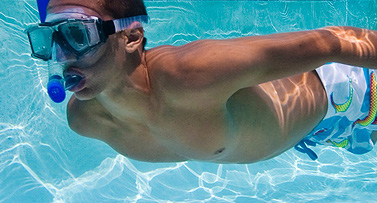16/08/2013Backyard Swimming Pool Basics
When it comes to backyard pools, there isn’t much mystery because all pools basically work the same way. Even though swimming pools come in all shapes and sizes, there are certain things that every pool, from a giant Olympic size pool to a kid friendly wading pool, has to have in order to keep the water clear and the pool clean. Here are the common components and what each does to make it possible to take a cool dip on a hot day.
The Basin
Every pool has to have a basin which is what holds the water. Pool basins can be installed above or below ground. Above ground pools are generally made from kits and the basin consists of an outer wall of metal, plastic, or wood and a vinyl liner. In-ground pool basins can be constructed of several different materials including fiberglass, gunite, concrete, and a frame and liner set-up similar to an above-ground pool.
The Pump
The pump is a critical component of every pool and is responsible for circulating the water from the pool to the filter and back again. This process helps keep the water clean by filtering out debris and helping to chemically treat the water in order to kill bacteria and algae.
The Filter
The filter helps keep the water clean, clear, and safe for swimming. There are three main types of filters in use today: sand filters, diatomaceous earth filters, and cartridge filters. Although each filter operates differently, they are all responsible for pulling dirt and debris out of the pool water so that the clean water can be pumped back into the pool. Check the local law regarding filter requirements or ask your local pool store for information on the required flow rate for filtering pool water. Most places have a requirement for how long it can take to run all the water in the pool through the filter in order to ensure the water is safe to swim in. Filters may also need to be backwashed from time to time to clear out built up dirt and debris. If you are unsure how often you need to backwash your filter, ask your pool professional for a recommendation.
The Chemicals
While most of the work to clean the water is handled by the pump and filter, the use of chemicals is also required to maintain the pool’s water quality. When it comes to the chemicals in the pool, the most important thing is maintaining the right balance of chemicals. Untreated pools can contain dangerous pathogens and can make it easy for bacteria and viruses to travel from one person to another. In addition to making sure the water is safe to swim in, maintaining the right chemical balance is also critical for protecting the different parts and systems that are part of the pool. If the pool has the wrong mix of chemicals, it can irritate and even damage the skin and eyes of swimmers.
The Drains
In order to get water to the pump and on to the filter, it has to exit the pool and in most pools that happens through main drains in the bottom of the pool and skimmers along the sides. Water flows through the drains or into the skimmers to be cleaned of debris, filtered, treated, and pumped back into the pool.



